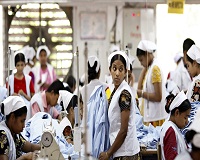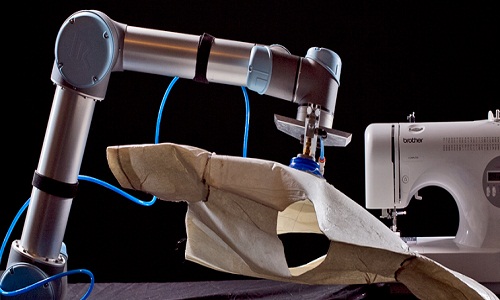"To keep up with rising demand, fast fashion companies have started resorting to measures which can enhance quality control standard operating procedures. Big brands have in-house quality control teams, whose job is to design, mandate, and audit processes for vendors to follow throughout production. One of the mandatory processes in garment manufacturing is fabric relaxation. Many fabrics, especially knits, need to be carefully handled to account for stretch that can be warped and affects the overall drape and fit of the final product. But at times, before the fabric pieces are sent through the sewing line, the fabric rolls are mishandled during spreading. Ram Sareen, Head Coach and founder, Tukatech, stated typical ‘relaxation’ necessitates that a factory takes a perfectly rolled fabric, open it onto a table, and leave it there for a day or two to settle. In this process, not only is the integrity of fabric harmed due to the handling and friction, but also one to two days are lost in the production cycle."
 To keep up with rising demand, fast fashion companies have started resorting to measures which can enhance quality control standard operating procedures. Big brands have in-house quality control teams, whose job is to design, mandate, and audit processes for vendors to follow throughout production. One of the mandatory processes in garment manufacturing is fabric relaxation. Many fabrics, especially knits, need to be carefully handled to account for stretch that can be warped and affects the overall drape and fit of the final product. But at times, before the fabric pieces are sent through the sewing line, the fabric rolls are mishandled during spreading. Ram Sareen, Head Coach and founder, Tukatech, stated typical ‘relaxation’ necessitates that a factory takes a perfectly rolled fabric, open it onto a table, and leave it there for a day or two to settle. In this process, not only is the integrity of fabric harmed due to the handling and friction, but also one to two days are lost in the production cycle.
To keep up with rising demand, fast fashion companies have started resorting to measures which can enhance quality control standard operating procedures. Big brands have in-house quality control teams, whose job is to design, mandate, and audit processes for vendors to follow throughout production. One of the mandatory processes in garment manufacturing is fabric relaxation. Many fabrics, especially knits, need to be carefully handled to account for stretch that can be warped and affects the overall drape and fit of the final product. But at times, before the fabric pieces are sent through the sewing line, the fabric rolls are mishandled during spreading. Ram Sareen, Head Coach and founder, Tukatech, stated typical ‘relaxation’ necessitates that a factory takes a perfectly rolled fabric, open it onto a table, and leave it there for a day or two to settle. In this process, not only is the integrity of fabric harmed due to the handling and friction, but also one to two days are lost in the production cycle.
It is often seen that about 8-10 workers handle fabric spreading, which increases manual dependency. When it is time for production spreading, that fabric is usually handled by at least eight, and sometimes by as many as fourteen or fifteen people, who catch and pull the fabric out of proportion as they lay it down. This creates uneven stretch about the fabric, and completely negates any relaxation that might have happened while the fabric was lying in a pile the day before. Factories are following the procedures as they are given, but sometimes these practices diminish the very quality they are seeking.
time for production spreading, that fabric is usually handled by at least eight, and sometimes by as many as fourteen or fifteen people, who catch and pull the fabric out of proportion as they lay it down. This creates uneven stretch about the fabric, and completely negates any relaxation that might have happened while the fabric was lying in a pile the day before. Factories are following the procedures as they are given, but sometimes these practices diminish the very quality they are seeking.
The same practices are often applied uniformly across all types of fabric, even if the necessity is not there. For example, fabric handling procedures for knit fabrics may be applied to denim, simply because it is a ‘stretch’ denim. Sareen highlighted that the stretch for denim is only in the width. You can relax the denim for ten years and it is never going to come back in length. These procedures become ingrained in local production culture, and changing these fixed processes becomes very difficult.
Fabric handling
Labour in the some countries is cheap, but labour accounts for less than 20 per cent of the total production cost. The cost of fabric, on the other hand, equates to 60-75 per cent of the garment cost. It is in the best interest of both brands and vendors to focus on handling fabric carefully, so that the human and material resources are not wasted, and the number of steps and time for manufacturing are reduced. Simplifying the fabric spreading process means reduction in the cost of labour, better product quality, and a shorter lead time. When fabric spreading is done automatically with a machine or on a mechanised trolley system the capacity increases.
Automatic fabric spreading ensures that every inch of fabric is aligned and gently handled from the time the roll is opened, until the pieces are cut and ready for sewing. Automatic fabric spreading machines come with tension-free mechanisms to unwind material from the roll, and constantly monitor the tension during spreading to keep consistent tension throughout the fabric. This means that relaxation for most types of fabric can be reduced or even eliminated from the production process, which saves one or two days, plus the required labour cost, and potential for lost fabric integrity.
Automation saves time
In addition to automatic fabric spreading, CAD systems help automate fabric planning and utilisation, as well as other pre-production practices. Accounting for fabric shrinkage, for instance, automatically adjusts the piece geometry, even for very tricky fabrics. Cut-planning applications then run order scenarios to ensure the best lay plans, and nesting algorithms calculate the best utilisation of the width of the fabric actually received. Such practices could save three to five days, 20 per cent of staff, and 3-12 per cent of fabric, as well as result in better quality garments.












